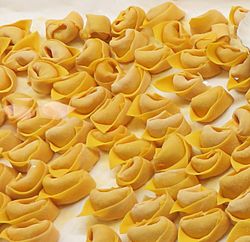Cappelletti (pasta) facts for kids
 |
|
| Type | Pasta, dumplings |
|---|---|
| Place of origin | Italy |
| Region or state | Emilia-Romagna, Marche, Umbria |
Cappelletti are a type of Italian pasta. Their name means "little hats" in Italian, because they are shaped like small hats! They are similar to tortellini but are usually bigger. Cappelletti also have a thicker dough and a different kind of filling inside.
This special pasta has a very old history. It comes from the Emilia-Romagna and Marche regions of Italy. Over many centuries, the recipe spread to become a popular dish in many Italian cities. Some people think Cappelletti first came from the area around Cesena, Ferrara, and Reggio Emilia. Others believe they have a long tradition in the Marche region.
Contents
Where Cappelletti Are Made
Cappelletti are a beloved dish in several parts of Italy. Each region often has its own special way of making them. This includes different fillings and ways to serve them.
Cappelletti in Emilia
In the Emilia region, Cappelletti have a long history. A very old text from 1556 might even mention them. This text was written by Cristoforo di Messisbugo, a cook for a duke in Ferrara.
The traditional Cappelletti from Ferrara often have a meat filling. This can include chicken, pork, or beef. They also add cheese, eggs, and a spice called nutmeg. The pasta dough is made in a similar way to other filled pastas. In Ferrara, there are two main types:
- Caplìt: These are filled with meat and cheeses. People usually eat them in a warm broth.
- Caplàz: These are larger and have a pumpkin filling. They are often served "dry" with a meat sauce called ragù, or with butter and sage.
Cappelletti are also a tradition in Reggio Emilia and Parma. They are especially popular during the Christmas holidays. The Cappelletti from Reggio Emilia look like small hats or rings. They are different from the anolini or Cappelletti made in Parma, even if their fillings are similar.
Cappelletti in Romagna
In the Romagna region, Cappelletti are a favorite dish for big celebrations. They are called caplét here. An old cookbook from Lugo even lists seven different recipes for them!
The filling for Romagna Cappelletti is usually made with cheese. This includes soft cheeses and ricotta. They add spices like nutmeg and grated lemon peel. Sometimes, they might also add chicken or other meats.
- In Faenza, the filling is only cheese-based. It has soft cheeses, parmesan, and nutmeg, but no meat. These Cappelletti are always eaten in a chicken broth.
- In the Imola area, the filling is made with meat.
The pasta dough is cut into squares about 5 cm (2 inches) wide. A spoonful of filling is placed in the middle of each square. These Cappelletti are best enjoyed in a meat broth. A good tip is to let them sit in the pot for a few minutes. This way, they soak up all the delicious broth!
Pellegrino Artusi, a famous Italian food writer, shared a recipe for Romagna-style Cappelletti. His recipe uses a filling of ricotta cheese, sometimes with chicken or pork. These are also cooked in a chicken broth.
Cappelletti in Marche and Umbria
Cappelletti are also a traditional pasta in the Marche and Umbria regions. While tortellini only became popular in some parts of Marche after World War II, Cappelletti have always been homemade there. This is especially true in the northern Marche area, which is close to Romagna.
In Marche, the filling for Cappelletti often uses stewed meats. These meats are cooked with vegetables like celery, carrot, and onion. Then they are ground up and mixed with raw eggs, grated aged cheese, nutmeg, and sometimes grated lemon peel. For big celebrations like Christmas lunch, Cappelletti in broth are a traditional first course.
In Umbria, Cappelletti in capon (a type of chicken) broth are a typical dish for New Year's Day. Unlike Romagna, where the filling is mostly cheese, the Umbrian recipe also includes mixed meats. This can be veal, turkey or chicken, and pork.
Eating Cappelletti "dry" with a meat sauce or other sauces is a more recent idea. Traditionally, they were almost always served in a warm, flavorful broth.
See also
 In Spanish: Cappelletti para niños
In Spanish: Cappelletti para niños

